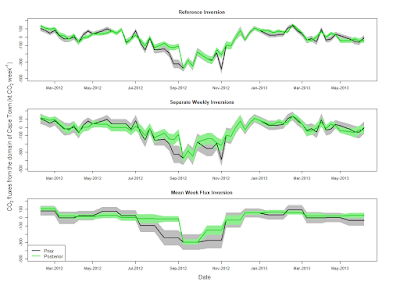The second part of the Cape Town inversion work has been accepted for review in ACP Discussions. Several components of the inversion were tested, which included alternative prior information products for fossil fuel fluxes (ODIAC) and biospheric fluxes, increasing and decreasing uncertainty estimates for both the observations and the prior fluxes, and removing error correlations. Those sensitivity tests which altered the uncertainty and correlations specified for the prior NEE fluxes had the largest impact on the inversion flux results, in terms of both the posterior flux estimates, their uncertainties, and the spatial distribution of these fluxes.
We also considered alternative control vectors. This dramatically reduced the computational time of the inversion. When solving for a mean weekly flux compared to individual weekly fluxes, the uncertainty reduction was substantially greater. Therefore disaggregating the fluxes into slow and fast components may be a way of capitalising on the observations to achieve greater uncertainty reductions.
By combining the information regarding the posterior flux estimates and their uncertainties from inversions with different prior information, the estimate of the posterior flux could be further refined.
 |
| Time Series Plot of Weekly Fluxes, Prior in Black with 95% Confidence Limits in Grey, and Posterior Estimates in Green. See Nickless et al. 2018 |
 |
| Percentage Uncertainty Reduction in CO2 Flux Estimates Using Different Control Vectors. The reference inversion solved for separate weekly fluxes within each month. See Nickless et al. 2018 |
